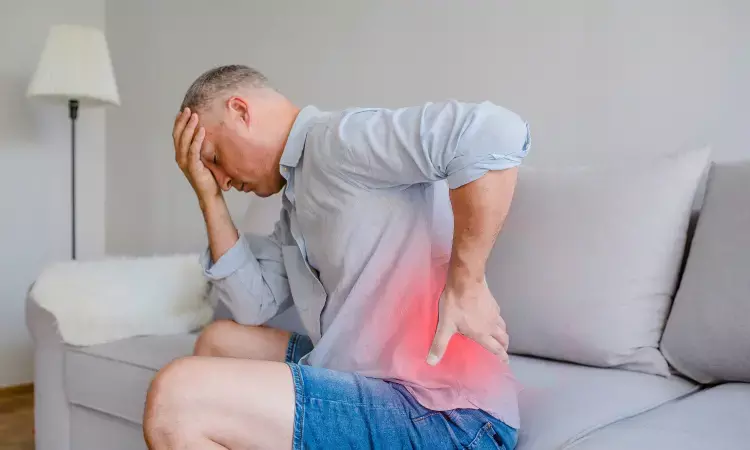- Home
- Medical news & Guidelines
- Anesthesiology
- Cardiology and CTVS
- Critical Care
- Dentistry
- Dermatology
- Diabetes and Endocrinology
- ENT
- Gastroenterology
- Medicine
- Nephrology
- Neurology
- Obstretics-Gynaecology
- Oncology
- Ophthalmology
- Orthopaedics
- Pediatrics-Neonatology
- Psychiatry
- Pulmonology
- Radiology
- Surgery
- Urology
- Laboratory Medicine
- Diet
- Nursing
- Paramedical
- Physiotherapy
- Health news
- Fact Check
- Bone Health Fact Check
- Brain Health Fact Check
- Cancer Related Fact Check
- Child Care Fact Check
- Dental and oral health fact check
- Diabetes and metabolic health fact check
- Diet and Nutrition Fact Check
- Eye and ENT Care Fact Check
- Fitness fact check
- Gut health fact check
- Heart health fact check
- Kidney health fact check
- Medical education fact check
- Men's health fact check
- Respiratory fact check
- Skin and hair care fact check
- Vaccine and Immunization fact check
- Women's health fact check
- AYUSH
- State News
- Andaman and Nicobar Islands
- Andhra Pradesh
- Arunachal Pradesh
- Assam
- Bihar
- Chandigarh
- Chattisgarh
- Dadra and Nagar Haveli
- Daman and Diu
- Delhi
- Goa
- Gujarat
- Haryana
- Himachal Pradesh
- Jammu & Kashmir
- Jharkhand
- Karnataka
- Kerala
- Ladakh
- Lakshadweep
- Madhya Pradesh
- Maharashtra
- Manipur
- Meghalaya
- Mizoram
- Nagaland
- Odisha
- Puducherry
- Punjab
- Rajasthan
- Sikkim
- Tamil Nadu
- Telangana
- Tripura
- Uttar Pradesh
- Uttrakhand
- West Bengal
- Medical Education
- Industry
Chronic low back pain linked to brain atrophy in pain related regions

Chronic low back pain (CLBP) is associated with reductions in brain volume in areas involved in pain processing, reports a study in PAIN®, the official publication of the International Association for the Study of Pain (IASP). The journal is published in the Lippincott portfolio by Wolters Kluwer.
"These findings suggest that CLBP is related to lower brain volumes of pain-related regions not only in clinical patients with severe pain but also in the general population," according to the report by Mao Shibata, MD, PhD, and colleagues of Kyushu University, Fukuoka, Japan.
Brain atrophy in pain-related regions seems specific to CLBP. As part of an ongoing Japanese study of disease risk factors (the Hisayama Study), the researchers analyzed brain magnetic resonance imaging (MRI) scans from 1,106 participants aged 65 years or older. On a study questionnaire, 17.1% of participants reported having CLBP, defined as low back pain present for 3 months or longer.
The remaining participants reported no chronic pain or chronic pain in areas other than the low back. Older adults with CLBP had lower education levels, higher rates of high blood pressure and depression symptoms, and lower rates of regular exercise.
In analyzing the MRI scans, the researchers focused on 10 brain areas with evidence of involvement in pain processing. The presence of CLBP was linked to reduced brain volume (atrophy) in 4 of the 10 areas – the ventrolateral prefrontal cortex, dorsolateral prefrontal cortex, posterior cingulate cortex, and amygdala – compared to participants with no chronic pain. In addition, a "significant cluster" (the left superior frontal gyrus) with reduced brain volume was identified in a relatively large sample size by using the QDEC (the Query, Design, Estimate, Contrast interface) approach, a method that did not prespecify brain region of interest.
The patterns remained significant after adjustment for a wide range of sociodemographic, health, and lifestyle factors. For older adults with chronic pain in other areas, regional brain volumes in pain-related areas were no different compared to subjects with no chronic pain.
Among participants with CLBP, those with more severe pain had lower brain volumes in pain-related areas, suggesting a "dose-response" effect. Some of the affected areas differed by age group – ie, participants aged 65 to 74 years versus those aged 75 years or older.
Chronic low back pain is a very common problem and the leading cause of years lived with disability. Yet approximately 90% of patients with CLBP cannot identify any clear specific cause or origin of their pain. A growing body of evidence suggests that CLBP is associated with lower brain volumes in pain-related brain areas.
The new study adds new evidence of atrophy in pain-related brain areas in a large population-based sample, with varying degrees of CLBP severity or other types of chronic pain. The researchers emphasize that the study participants had not necessarily sought any treatment for CLBP. That's a new finding, as most previous studies have focused on patients receiving care for severe chronic pain.
The researchers acknowledge some key limitations of their study: it cannot show any cause-and-effect relationship and cannot account for unmeasured factors, such as pain medication use, that might affect brain volumes. Dr. Shibata and colleagues conclude, "Further investigations are needed to clarify the mechanism underlying the association between CLBP and regional brain atrophy."
For more information, visit here:
Dr Kamal Kant Kohli-MBBS, DTCD- a chest specialist with more than 30 years of practice and a flair for writing clinical articles, Dr Kamal Kant Kohli joined Medical Dialogues as a Chief Editor of Medical News. Besides writing articles, as an editor, he proofreads and verifies all the medical content published on Medical Dialogues including those coming from journals, studies,medical conferences,guidelines etc. Email: drkohli@medicaldialogues.in. Contact no. 011-43720751


